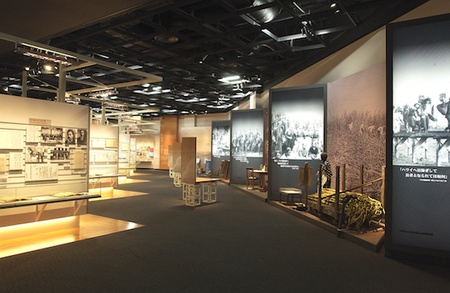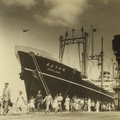Support for Nikkei Communities
Before World War II, Japanese overseas migration projects were conducted by the central government, prefectural governments and private companies. After World War II, with the number of people who migrated to foreign countries decreasing, the Japan Emigration Service (JEMIS) was established in 1963 and started to facilitate centralized overseas migration projects in 1964. In 1974, JEMIS and the Overseas Technical Cooperation Agency, which implemented technical cooperation for developing countries, were integrated into the Japan International Cooperation Agency (JICA), and JICA took over overseas migration projects. Subsequently, JICA began to provide assistance with stabilizing and establishing emigrants’ lives and circulating surveys and knowledge about overseas migration as part of its operations.
Currently, JICA conducts a range of support projects for Japanese emigrants and their descendants living abroad. For example, the Education Program for Nikkei Next-Generation, which is a training program in Japan, is intended to help Nikkei junior high school students, high school students and university students to deepen their understanding of Japan and strengthen their identities as Japanese descendants by inviting them to Japan and providing them with the opportunity to study the Japanese language, stay in Japanese homes, have exchanges with Japanese students and study the history of overseas migration for around one month. In addition, the Program for Developing Leaders in Nikkei Communities is a project for supporting Japanese descendants who study at Japanese graduate schools with the expenses for their stays in Japan and school expenses.
The Nikkei Training Program is a project in which JICA outsources the implementation of training programs for Japanese descendants to Japanese local governments, universities and NGOs on the basis of their proposals. This training program covers a wide range of areas, including medicine, welfare, agriculture and IT.

For example, the Improvement of Nurses’ Management Skills by 5S-Kaizen, which was conducted in Japan in 2016 for around one month, was a training program in which six Nikkei nurses from two Brazilian hospitals participated. This training program was intended to improve the quality of hospital services, patients’ satisfaction and medical security by introducing 5S [seiri (sort), seiton (set in order), seiso (shine), seiketsu (standardize), shitsuke (sustain)] and kaizen (improvement).
In Japan, the participants acquired knowledge of 5S-Kaizen and studied specific cases through lectures and inspection visits to hospitals. After returning to Brazil, the participants strived to improve their working environment by practicing the principles of 5S-Kaizen, including keeping the files on hospital shelves in order and placing portable examination instruments in the corridors in particular positions, as well as conveying the knowledge they had acquired in Japan to their coworkers.
In addition, since 2013, JICA has sent survey missions in which Japanese companies participate for the purpose of solving developing issues through the collaboration between Japanese descendants living in Latin America and the Caribbean and Japanese companies, and facilitating Japanese companies’ business development in Latin America and the Caribbean.
C-Eng Sales, an Aichi-based company that participated in the Survey Mission in Coordination with Brazilian Nikkei Hospitals, which was conducted in 2017, visited hospitals managed by Japanese descendants and introduced its own medical mattress that has superior high resilience and enables the patient to move easily, meaning that it is considered to be effective for preventing bedsores. The company, which decided to make inroads into the Brazilian market through this experience, plans to commence the sale of medical mattresses to medical institutions with the support of JICA’s Small and Medium-sized Enterprise Partnership Promotion Survey.
“Most of the patients in hospitals run by Japanese descendants are non-Nikkei people,” says Yoshida. “We believe that we will be able to contribute to developing Brazilian society as a whole by providing support for Nikkei communities.”
Japanese volunteers also work together with Japanese emigrants and their descendants. JICA’s Youth and Senior Volunteers for Nikkei Communities is a system of sending young and senior Japanese volunteers to Nikkei communities in various areas such as Japanese language, health, welfare and sports.

Some of these volunteers perform well beyond the borders of Nikkei communities. For example, Kuroki Go, who had worked as a health and physical education teacher at a Japanese public junior high school, was dispatched to São Paulo, Brazil, as a youth volunteer for Nikkei communities and coached the baseball team of Nikkei children for two years starting from 2009. Kuroki conducted Japanese-style coaching with an emphasis on politeness, discipline and manners, and steered the team to third place nationwide. In addition, Kuroki was selected as the coach of the Brazilian national team for the World Baseball Classic (WBC), which was held in the United States in 2013, and made a significant contribution to improving the level of Brazilian baseball.
JICA also provides support for cooperative activities conducted by Japanese local governments, universities and NGOs for Nikkei communities through the JICA Partnership Program. For example, JICA supported the Project for Development of Psychological Support for Returnee Dekasegi and Their Children in the State of San Paulo, which was conducted from 2012 to 2015.
Dekasegi is a Japanese word that means “work away from one’s hometown.” Japan revised the Immigration Control and Refugee Recognition Act in 1989 as part of its measures for addressing the shortage of workers, and enabled Japanese descendants living abroad to work in Japan. This policy shift sparked a sharp increase in the number of Japanese descendants who come to Japan to work away from their hometowns, and Japanese descendants (mainly Japanese-Brazilians) became an important workforce for supporting Japanese industry, especially the manufacturing sector. After the number of Japanese-Brazilian residents in Japan peaked at about 310,000 in 2007, however, it decreased due to the economic slowdown in Japan, reaching about 180,000 in 2016.
Some Brazilian children who returned to their home country with their parents were unable to adjust to life in Brazil and suffered from mental stress. In response to this situation, the project supported the establishment of local support systems and the development of counselors’ skills through the cooperation between Japanese local governments and NGOs.
In addition to these support programs for Nikkei communities, JICA also works to circulate surveys and knowledge about overseas migration and Japanese emigrants and their descendants. In 2002, JICA opened the Japanese Overseas Migration Museum in Yokohama, Kanagawa as part of these efforts. The permanent exhibition of the museum introduces the backgrounds of Japanese overseas migration and the work and lives of the emigrants in the countries they immigrated to using photos, movies and models.
“We hope that we will be able to establish a network among overseas migration museums in each country and construct an online virtual museum about Japanese emigrants. By these efforts, we hope more people will come to know about another side of Japanese history, and the hardship and happiness that Japanese experienced in the beginning of globalization,” says Yoshida. “Japanese people do not have sufficient knowledge of the history of Japanese emigrants. Today, people from many different countries visit and live in Japan. We believe that in order for Japan to create an open-minded culture that welcomes diversity in the future, it is important to share the experience of the Japanese emigrants who participated in the nation-building in Brazil as one of multiple nationalities to do so.”

*This article was originally published on TJJ OnLine on June 1, 2018.
© 2018 The Japan Journal



